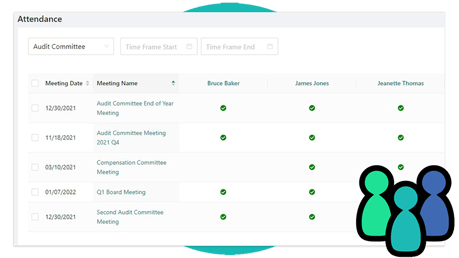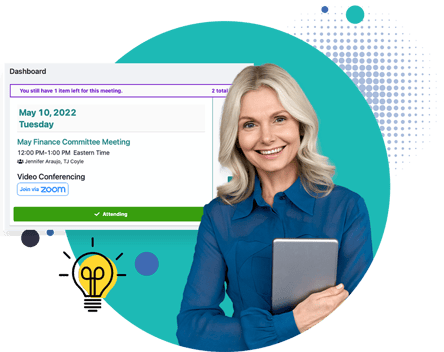Nearly every company will hold formal board meetings at least once in a while. It might be an annual board of directors meeting, a meeting to resolve an urgent issue or a meeting ahead of an annual general meeting. Board meeting minutes provide a record of the matters discussed and the actions taken at the board meeting and are used to inform shareholders and defend the board’s decisions in legal proceedings.
Meeting minutes are a critical part of the board governance process. These four core elements ensure that you will have organized, useful, and streamlined meeting minutes for every important meeting.
1. Establishing an Agenda
 When planning for a board meeting, adhering to key best practices keeps your meetings running smoothly. First, it is essential to ensure that a clear agenda is created and includes all pertinent discussion topics for the board meeting. Both the agenda and relevant supporting materials should be distributed with enough time for the members to digest them, prepare any questions, and request any changes. Because of the limited time you have with the company’s leadership, the agenda should focus on issues that should be addressed rather than what is going well at the company. After the meeting is called to order, another opportunity is generally offered for board members to request changes to the agenda.
When planning for a board meeting, adhering to key best practices keeps your meetings running smoothly. First, it is essential to ensure that a clear agenda is created and includes all pertinent discussion topics for the board meeting. Both the agenda and relevant supporting materials should be distributed with enough time for the members to digest them, prepare any questions, and request any changes. Because of the limited time you have with the company’s leadership, the agenda should focus on issues that should be addressed rather than what is going well at the company. After the meeting is called to order, another opportunity is generally offered for board members to request changes to the agenda.
The agenda will help build a template for the board meeting minutes, which should start with the company’s name, date, time, location of the meeting, and meeting type. Every board member should be listed, and designated as either ‘absent’ or ‘present’. Note any late arrivals or early departures and any visitors, and show whether a quorum was present to take votes. Having a quorum is essential, as it ensures that there is a majority for board decisions. It is generally thought that 2/3 of board members constitutes a quorum, but Robert’s Rules of Order says that a quorum “should approximate the largest number [of members] that can be depended on to attend any meeting except in very bad weather or other extremely unfavorable conditions.”
The template that starts with the agenda should include a section for each routine part of the meeting. This will include approving past meeting minutes, going over reports (like the Treasurer’s Report), reviewing ‘old’ business, discussing ‘new’ business, and agreeing to hold any remaining items over for the next meeting. Use the agenda to add categories under each section. Close the template with the date, time, and location of the next meeting. Add the times the meeting began and ended, as well as the time the meeting was called to order and adjourned.
2. Full Record of Board Meeting
The board secretary should take thorough notes on the discussion in whatever way is easiest and make sure that they reflect each action taken as well as its reasons. All motions should be memorialized, and make sure to include who seconded the motion. If a voice vote is taken, then a simple sentence saying a motion passed is sufficient. If a counted vote is taken, then a tally of yays and nays should be detailed. In every case, a description of the motion should be included in the board meeting minutes.
The secretary can record the meeting to make sure all information is captured but should inform board members that they are being recorded. For recorded meetings, it is best practice to note the time the recording starts and the time that each action is taken. This will make it easier to find significant topics later, so the secretary doesn’t have to listen to the entire meeting to get to a specific point.
3. Refining Board Meeting Minutes
As soon as the meeting is over, the secretary should type up the notes and edit them down to the necessary points. The secretary should double-check things like spelling, acronyms, and jargon to make sure everything is correct and easy to understand. Past tense should be used throughout the minutes document, and bullet points rather than paragraphs should be utilized to make it easier to skim through. The secretary should make it obvious who made and seconded motions and when votes took place, as well as who agreed to take on specific tasks.
Govenda’s Task Management function allows boards to track assigned tasks easily.
Board minutes should be concise and direct. They do not need to include every board member’s opinion, give details of individual presentations, or include context from past meetings. However, they can include an appendix with related documents or a footnote explaining where to find them. Including personal observations or inflammatory remarks in the meeting minutes should be avoided.
4. The Feedback and Approval Process
After the secretary has compiled the minutes from the board meeting, the board president can follow up with feedback and approve the minutes while the meeting is still fresh in their mind. Once approved, the board meeting minutes can be distributed to the rest of the board of directors. Any errors in the minutes should be resolved quickly, and new copies should be distributed, noting its revision and date of revision.
Board meeting minutes do not need to be made publicly available – and in many cases they should not be, because they detail confidential or sensitive issues. However, past board meeting minutes should always be readily accessible to board members and shareholders as they will provide a formal record of the proceedings.
Govenda Streamlines Meeting Minutes
 The easiest way to manage meeting minutes is electronically through a board portal. Leveraging a board portal reduces paper expenses, allows for easier distribution, and simplifies all involved processes. Many organizations are looking to board management solutions, like Govenda, to achieve these goals.
The easiest way to manage meeting minutes is electronically through a board portal. Leveraging a board portal reduces paper expenses, allows for easier distribution, and simplifies all involved processes. Many organizations are looking to board management solutions, like Govenda, to achieve these goals.
Engineered for board administrators to streamline minute taking before, during, and after meetings, Govenda simplifies board management of action items and board of director notifications. Govenda integrated board meeting minutes software is an effortless approach to minute taking that is flexible to adapt to your unique needs. Import a current agenda or create a new template with the help of our fully functional text editor. Add action items, board business, and attendance in an easy and elegant dashboard. After electronically sending minutes for approval, securely purge all drafts, and store in your paperless board book.
A seamless solution to minute taking and management, Govenda meeting minutes software is integrated in the secure Govenda board portal platform – no additional apps or fees required!
Managing your meeting minutes with a modern board portal solution like Govenda is the easiest and most secure way to manage board business and maintain corporate governance.
Schedule a demo today to see how we can help your board.
Other posts you might be interested in
View All Posts
Preparation of Board of Directors Meeting Minutes
Read More
Best Practices for Creating and Approving Meeting Minutes
Read More
Govenda Announces Integrated Meeting Minutes Functionality
Read MoreSubscribe to email updates
Get updates delivered directly to your inbox.
 Board Management Software for Better Governance
Board Management Software for Better Governance Govenda Brochure
Govenda Brochure